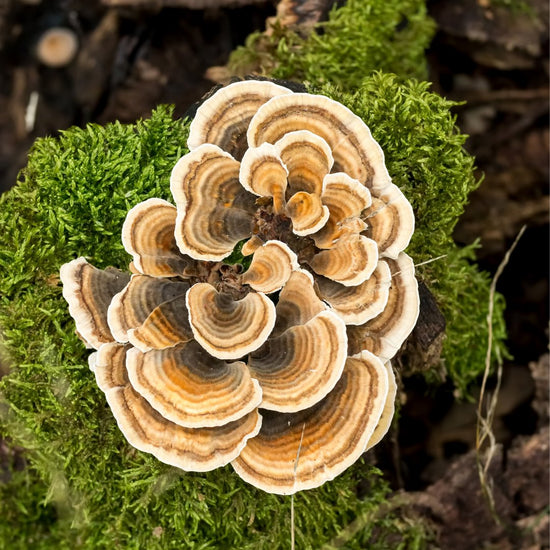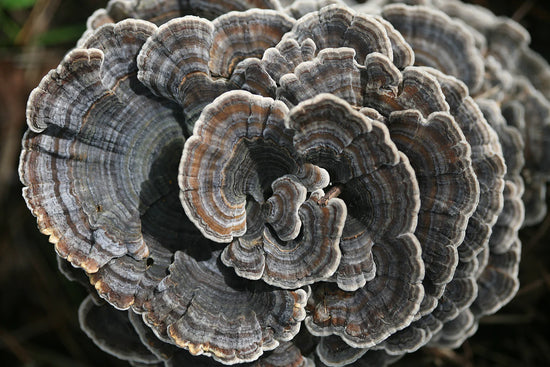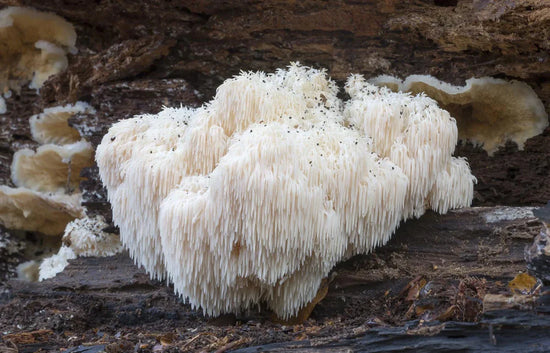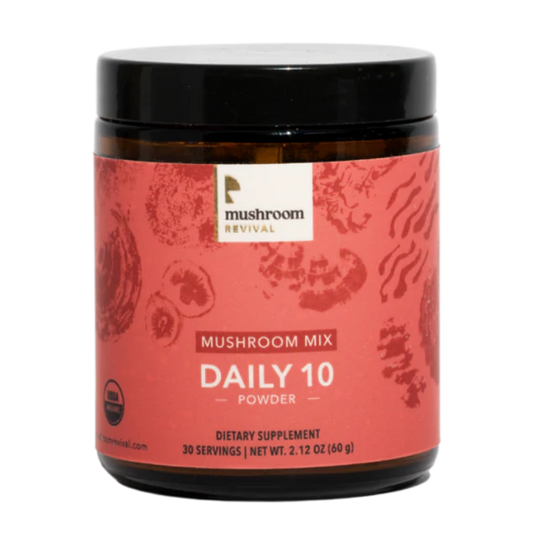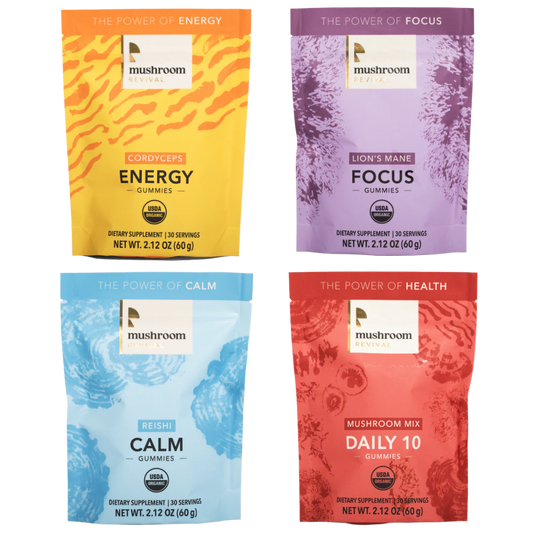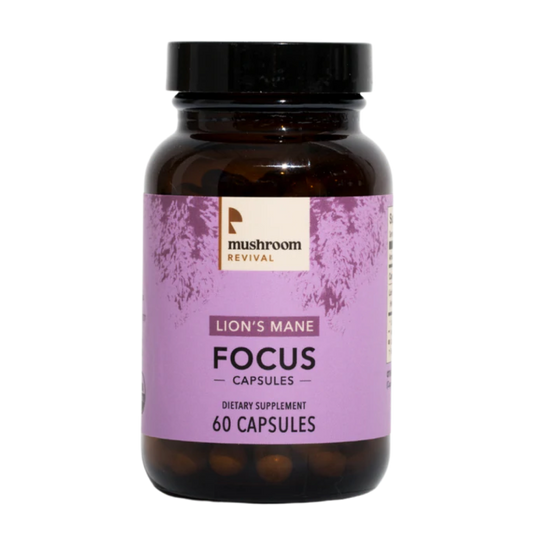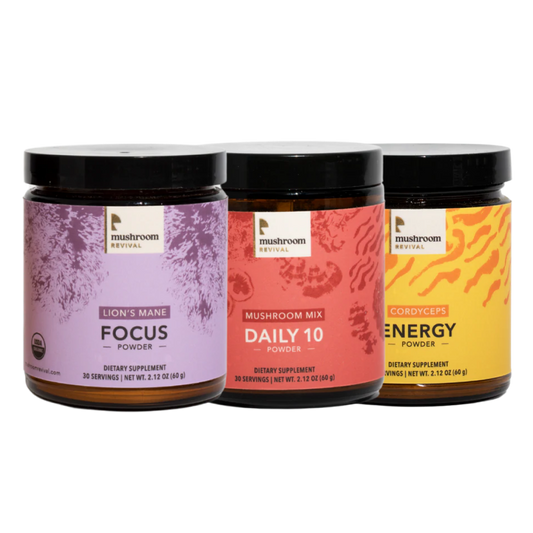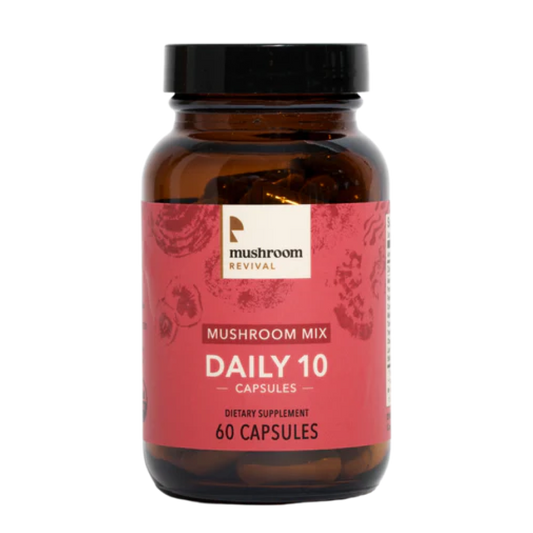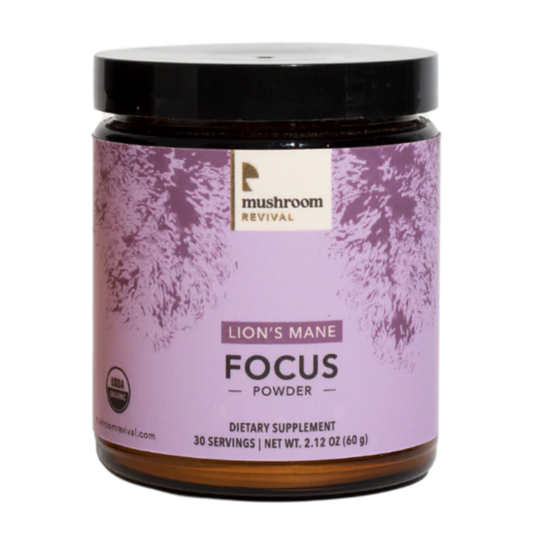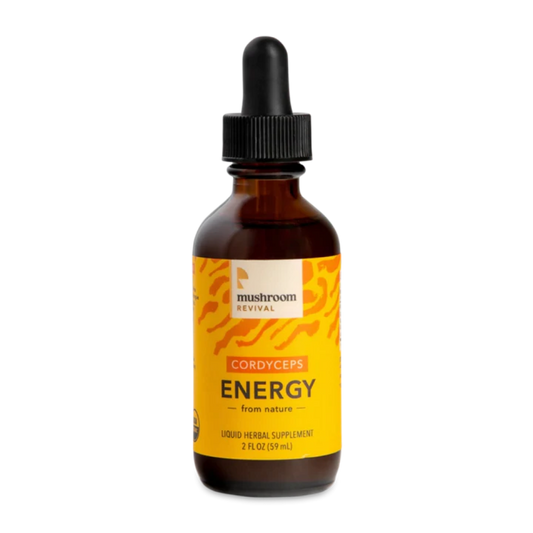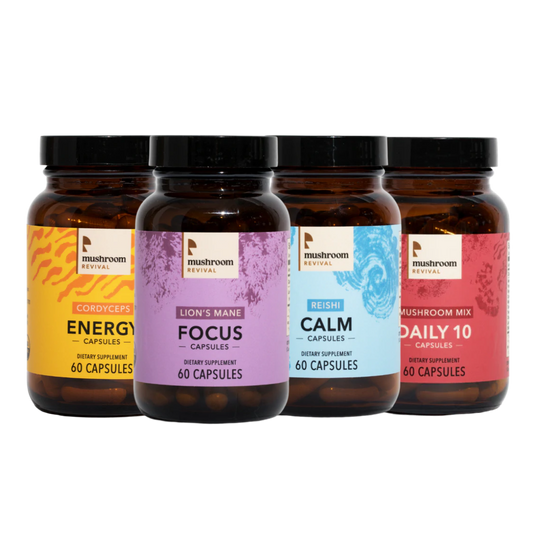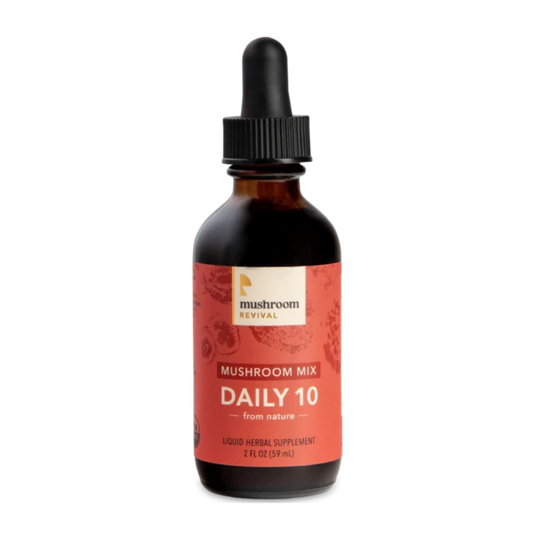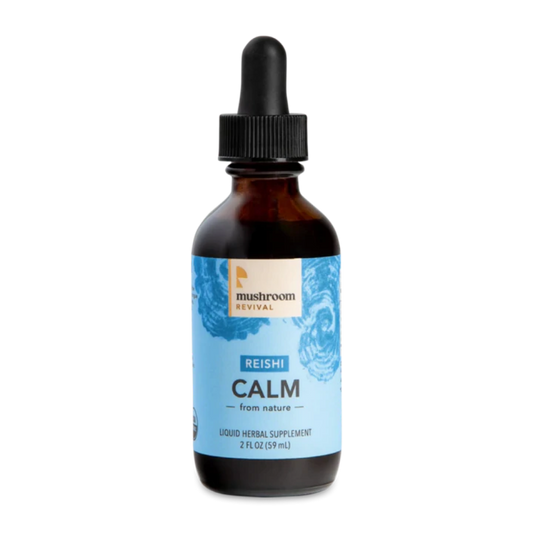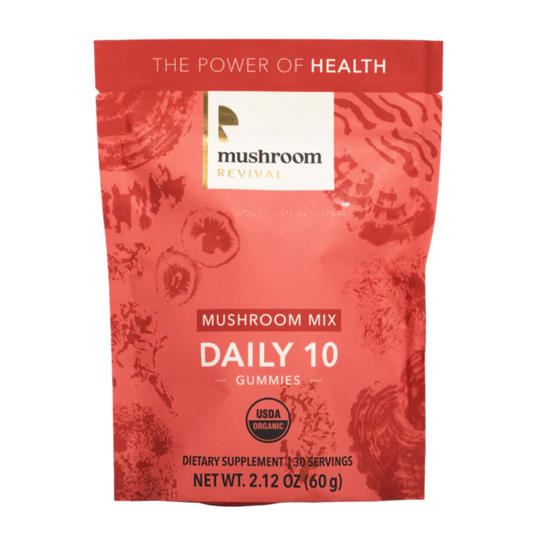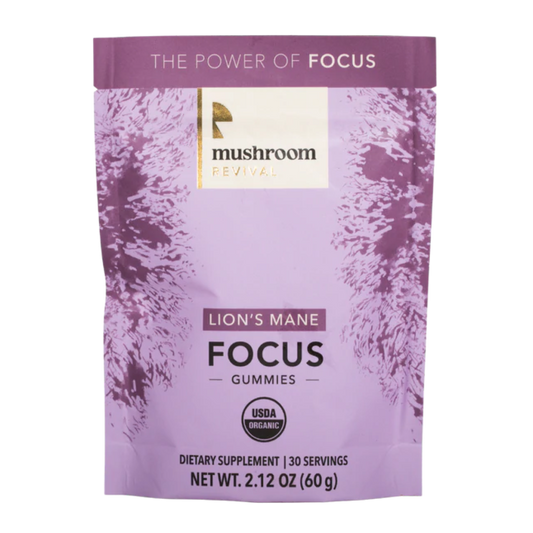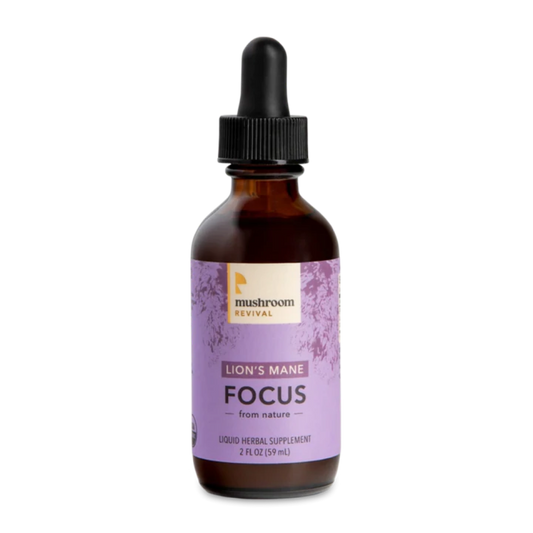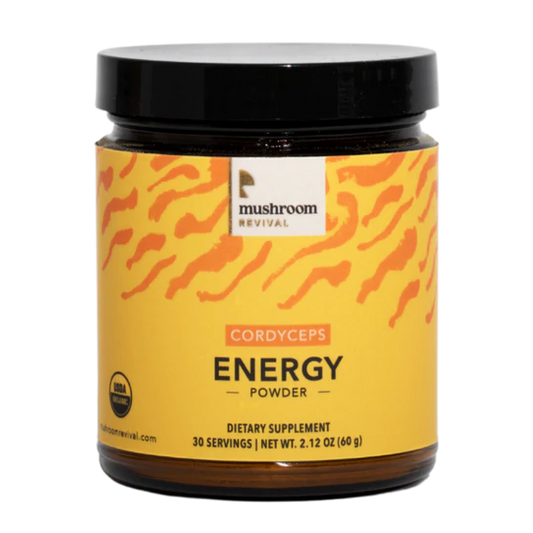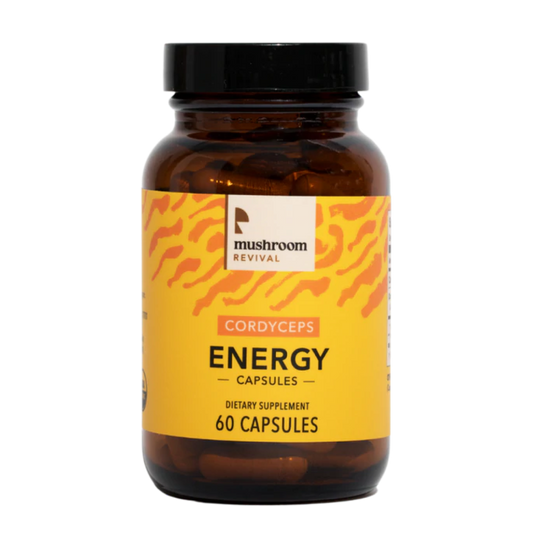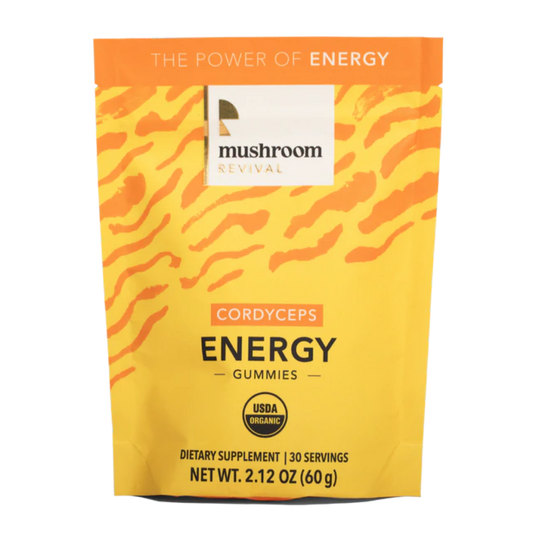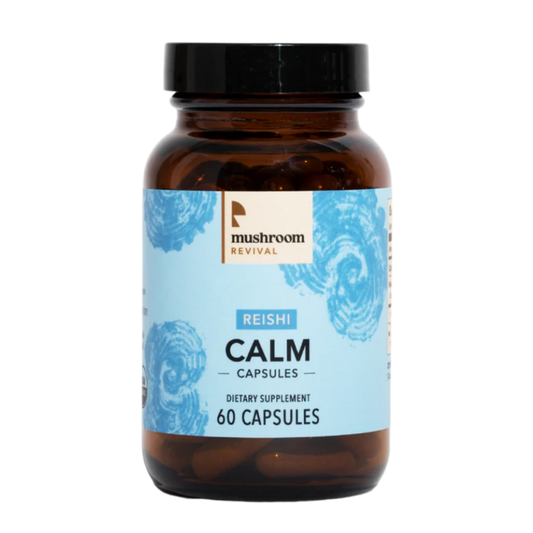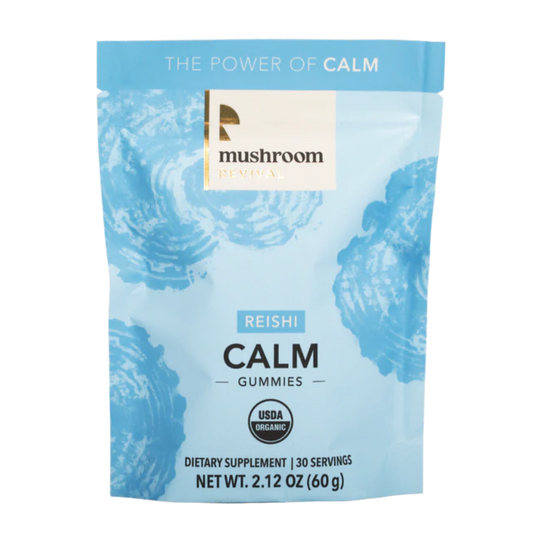Mycelium vs Fruiting Bodies of Functional Mushrooms w/ Jeff Chilton
Jeff Chilton teaches us why mushroom products are better than mycelium ones.
Podcast Topics
- About Jeff Chilton’s background, education, and work
- On Oaxaca, Mexico and Maria Sabina
- The life cycle of mushrooms
- Growing mushrooms and different techniques
- Mycelium vs. mushrooms and their medicinal values
- The medicinal mushroom industry
- Nammex’s 2015 Research Study: Redefining Medicinal Mushrooms
- How myceliated grain products have little medicinal value
- False marketing for mycelium products and the FDA compliance documentation of 1976
- Proximate analysis of grain mycelium-based products and how they are indeed a food product
- Beneficial compounds in functional mushroom supplements such as beta-glucans
- Serving sizes, monthly dosages, and Lion’s Mane cognitive testing
- Ratios and extraction processes
- Chinese technology and the origins of the mushroom industry in China
About Jeff Chilton
(Jeff is pictured on the right)
Episode 30 is a critical episode for demystifying the functional mushroom market. Today we are speaking with Jeff Chilton, co-author of The Mushroom Cultivator and trusted functional mushroom expert. We dive deep into the science behind producing quality mushroom supplements, with a large focus on the misinformation on mycelium vs. mushroom fruit bodies.
Jeff Chilton studied Ethno-mycology at the University of Washington in the late sixties. He founded Mycomedia in the late seventies which held “4 mushroom conferences in the Pacific Northwest” (1c.) In 1973, he began a 10-year career as a large-scale commercial mushroom grower. Then in 1989, Jeff established Nammex, the first company to supply mushroom extracts to the nutritional supplement industry. Finally, in 1997, he organized the first organic certification workshop for mushroom production in China.
In the podcast, Jeff shared one thing he wants all the listeners of the podcast to know: “people should really put mushrooms into their diet.” It has been discovered that populations that eat mushrooms live longer and are healthier. Strains such as shitake, oyster, maitake, and enoki are great starting points. Not only should we eat mushrooms, but taking supplements is also very beneficial. Continue reading to discover how to source the best mushroom products to supplement your health.
Nammex’s Quality Control on Mushroom Supplements
Jeff’s company, Nammex, has been in the game of producing organic mushroom supplements since 1989. He guarantees that his products have a certain amount of beneficial compounds such as beta-glucan as the business depends on analysis for quality control. He believes that the act of testing is extremely important and foundational to creating qualified products.
Beta-glucans are the key medicinal compound in mushroom supplements. The top 12 medicinal mushrooms in the world have the highest and most active levels of it. They “potentiate the immune response,” which means they strengthen the immune responses by activating immune cells. Mushroom products have an abundance of this compound, but mycelium products barely have any of this compound in them.
Without verifying the number of active compounds within products, there would be no consistency in the quality of functional mushroom supplements. Ultimately, testing “keeps the marketplace relatively free from products that are devoid of medicinal value” (4). Luckily, Nammex has been utilizing testing methods for over 15 years.
The company’s goal is to heighten consumer confidence in quality mushroom goods by creating a level of integrity that supplement companies should strive to meet. However, there is an “ongoing industry issue” of adulterated mushroom products (4). Companies producing mycelium on grain, also known as, “grain spawn” supplements have been around for 50 years. Yet, they continue to produce inexpensive and starch-diluted products.
“I haven’t found one scientific paper that displays mycelium or mycelium on grain being more potent than the actual fruit body or the actual mushroom… I found dozens and dozens of papers that prove… the opposite.”
— Alex Dorr, Mushroom Revival
Redefining Medicinal Mushrooms Report
Image from Redefining Medicinal Mushrooms
The mushroom-growing industry continues to face issues with silly starch-diluted mycelium products. Over time, the medicinal mushroom business experienced fast growth, “but few actual quality control standards” took hold (4). Thankfully, integral companies such as Nammex have been redefining what it means to create a quality mushroom fruit supplement.
In Jeff’s report, Redefining Medicinal Mushrooms, we discover that starch is an indicator of adulteration. And in the study, Jeff and his team analyzed 95 different supplement samples. These included mushroom supplements, extracts, and 40 different mycelium on grain products. The research concluded that supplements made from actual mushrooms contained way more beneficial compounds in comparison to “so-called mushroom” or myceliated grain products. The latter was compromised with an abundance of starch.
Many myceliated grain companies talk about how they’re products contain mushrooms, but in actuality, there is “very little fungal matter” in them. This is based on scientific research. The mycelium businesses are actually selling what is mostly powdered grain. In the end, any of their products that are marketed with pictures of mushrooms on the front panels are lying. What consumers are buying aren’t mushrooms. They aren’t even a “true fungal product” because even the amount of mycelium contained in them is very low.
Mycelium Supplements Are Confusing Consumers
In the marketplace, many mycelium companies are selling products that don’t have much fungal matter in them. To understand this properly, let’s look at the different stages of a fungus. Just as herbs have different states such as the root, leaf, or fruit — mushrooms have different parts too. Harvest can take place at any stage, but each product has very different attributes. For a mushroom, the main products are the spore, mycelium, and mushroom.
Below is an image of the mushroom cycle. There are the spores, the mycelium, and the actual mushroom fruit. All three of these stages are “currently utilized for their medicinal properties” (4). With this understanding, it will be easier to recognize what parts of the mushroom supplement companies are using. Further, it shows what businesses are basing claims on. It is important to know which part of a mushroom a supplement company is deriving its ingredients from.
If a company is using mycelium, then they are using the vegetative parts of a mushroom — not a mushroom. So when myceliated grain businesses depict a mushroom fruiting body on the front panel, they are misleading customers. It would be correct to put a picture of mycelia, as shown below, on the packaging instead. It would also be correct to label the product Reishi mycelium, not “Reishi mushroom mycelium” because mushrooms and mycelia are separate entities (4).
"Mycelium" by harrington_alison is marked with CC BY-SA 2.0.
This mislabeling, AKA lying, is a problem in the industry as it confuses customers. According to the Food and Drug Administration (FDA), mycelium-based products are considered food products, not supplements, and should be labeled as so. This is based on the FDA’s compliance documentation of 1976, which states “[m]ushroom mycelium grown in acceptable media is regarded as suitable for food use... [l]abeling should not suggest or imply that the food contains mushrooms” (5).
“If you want people to experience mushroom medicine and revolutionize their health and their first experience is with this rice powder… these people might just give up… they could have really helped themselves if they had access or knew what they were buying.”
— Lera Niemackl, Mushroom Revival
Why Do Mycelium Products Exist? And What’s Inside Them?
"mycelium" by harrington_alison is marked with CC BY-SA 2.0.
"wet reishi" by Wendell Smith is marked with CC BY 2.0.
The reason why companies continue to produce mycelia products is that mushrooms are very expensive to grow. Mycelium on the other hand is a “very simple structure” that comes from the vegetative state of the mushroom as shown above. It grows in the ground, in wood, in trees, then in the right conditions, the mycelia turns into a mushroom. But this process is taxing. So, the process of growing mycelia is a lot more inexpensive than going for the fruit.
So, what’s inside the mycelium products? They consist mainly of starch from residual grain. They are low in fungal matter (actual mushrooms) and the beneficial and medicinal component, beta-glucans. They also follow the nutritional value of the grain it is grown on. In essence, there is barely a hint of mushroom.
Moreover, Jeff’s company, Nammex, tested for starch to see how much of the “supplement” was grain. “On average, mycelium products on grain contained 35–40% starch” (4). This provided evidence that grain spawn products have very few beneficial compounds. On the other hand, mushroom supplements contain 3% starch in dry weight. And they have high levels of beneficial compounds, which range from 30-40% as compared to mycelium products which average 3-7%. Simply put, the two products are completely opposite of one another.
The testing from Nammex showed that mushroom fruiting bodies are the most medicinal aspect of the mushroom’s growing cycle. They produce a range of beneficial compounds that have been helping people for thousands of years, are low in starch, and contain prebiotic fiber. They are the true “full-spectrum” stage of the fungal organism. In total, mushrooms have a different set of genetics that produces interesting compounds that mycelium just doesn’t have.
Remember To Look at the Ingredients
In the end, mycelium-based companies should tell their customers what their products truly are. They are food products because the contents are mostly starchy grains. And they are not mushroom supplements. Even the mycelium within those products is low. What people are eating is similar to powdered rice. It’s more like a fermented grain such as tempeh.
Moreover, mycelium products have “people and companies [behind them] that are trying to desperately claim medicinal mushroom status when… they are nothing more than tempeh.” The products are misleading and false. So, when you look for mushroom supplements, remember to specify on the ingredients label that the product is made from actual mushrooms. Avoid anything that states “mycelium” on the back panel in small font.
Podcast Show Notes & Works Cited
- Jeff Chilton’s Websites & Bio
-
https://www.nammex.com/
- Educational Area: https://www.nammex.com/mushroom-education/
- Retail: https://www.realmushrooms.com/
- Bio: https://www.acvbm.org/Bio-Jeff%20Chilton.pdf
- Book: The Mushroom Cultivator by Jeff Chilton and Paul Stamets: https://www.amazon.com/Mushroom-Cultivator-Practical-Growing-Mushrooms/dp/0961079800
- Report Download: “Redefining Medicinal Mushrooms: A new scientific screening program for active compounds:” https://www.nammex.com/redefining-medicinal-mushrooms/
- PDF: “Redefining Medicinal Mushrooms:” ”https://prod-media.megazyme.com/media/pdf/a1/6e/dd/redefining-medicinal-mushrooms.pdf
- https://www.fda.gov/regulatory-information/search-fda-guidance-documents/cpg-sec-585525-mushroom-mycelium-fitness-food-labeling
Shop All Mushroom Revival Products
TRANSCRIPT
Welcome welcome mush fam to another episode of mushroom revival podcast. This is a podcast dedicated to bridging the gap between you lovely listeners and the mystical magical world of mushrooms. So mushroom revival is a medicinal mushroom company based in western Massachusetts. And our mission is to give you more energy, a better night's sleep, a clear mind and a bulletproof immune system with medicinal mushrooms. We not only revitalize inside, but also outside for planting a tree for a product that we sell our holiday sale going on if you're tuning in December 2019. Our sale ends December 9. So check it out on our website if you want to catch a deal. Also check out all of our free resources or blog posts or podcasts and lots more, you can download a free ebook. And there's a lot of fun stuff on our website at www dot mushroom dash revival. In other news, we have an amazing guest, Jeff Chilton, and super super grateful to have him on our show and this is going to be an amazing episode.
Lera :
Okay, everybody welcome Jeff Chilton, who studied ethnomycology at the University of Washington in the late 60s and the 1973 began a 10 year career as a large scale commercial mushroom grower. Jeff is a founder of Mycomedia and is the co author of the mushroom cultivator published in 1983. In 1989, Jeff established Nammex, the first company to supply medicinal mushroom extracts to the nutritional supplement industry. And in 1997, he organized the first organic certification workshop for mushroom production in China. So, thanks, Jeff. So excited for all those topics we're gonna cover. Hey, thank you very much for having me. I'm really excited to be here today. Yeah, so we always ask our guests first off how you got into mushrooms.
Jeff:
Well, you know what I'm looking out right now at a beautiful forest. It's born and raised in Washington State and Washington is the Evergreen State. That green forest comes with a lot of rain. So so we have it's a very rainy climate out here and and it's actually one of the best climates in the world for mushrooms. So I grew up with mushrooms all around me I had a bit of a fascination with them, hunted them early as a teenager with parents of friends and then at university and with the University of Washington I decided that well my my my my major was anthropology because I really interested in other cultures, but I I also took mycology courses and ended up basically studying ethno mycology, which is the study of mushrooms worldwide as food as medicine and in shamanic purposes, so an ancient religion so it was all very interesting to me. I just loved the whole subject. And then when I finally got out of university and realized there are no jobs in anthropology, I thought it'd be so cool to grow mushrooms. And so I found a job at the only mushroom farm in Washington State, a very large commercial mushroom farm and I was there for the next 10 years. I literally lived with mushrooms for 10 years.
Lera :
Well, yeah, I think you read the I read that. You were producing 2 million pounds of Agaricus a year. Is that right?
Jeff:
Oh, yeah, absolutely. 2 million pounds and and we had about probably 40 to 50 different, what we'd call houses, some very old style mushroom houses, made out of wood, and then others that were very new, which were just like big concrete warehouses, and so we had lots of crops going on at the same time. But the really cool thing was is that while I was there, we had a Japanese scientist who was in charge of research and development and he was growing talky, he was growing in gnocchi, and he was growing oyster mushrooms and so I was involved in the cultivation and these other what we called specialty mushrooms. And so early on, I mean, this is in the 70s, I had a chance to see other mushrooms growing by different growing methods. And also can you imagine it's the 1970s. And I'm eating fresh shiitake.
Alex:
That's, that's pretty incredible. And it's funny now, you know, those are not so specialty here in the United States. And, and, you know, beyond, which is it's really awesome. And it's, it's amazing to see the mushroom industry really evolve and spread across the world. I remember I was in wahaca, Mexico, I'd say about three years ago, and I went to live at this house and this kid was growing mushrooms, I was helping him out. And he had the mushroom cultivators really beat up and it was passed a house by his, his dad onto him. And he was like, This is the mushroom Bible, you know, and if no one knows we're talking about is a mushroom cultivator, which Jeff co wrote, published in 1983. And it's, it's used all around the world. And it's, it's thought of as the mushroom cultivation Bible, it's, you know, it's amazing. And even to this day, there's a lot of amazing, really top notch information in there. And that's how I first, you know, heard of you, Jeff, and I'm so really grateful to have met you in China not that long ago, and which was an amazing trip, looking forward to the next time and you actually inspired me to get out there and go to this Minnesota mushroom conference. So I'm really grateful that. I listen to you and I bought the ticket. And it was Yeah, it was life changing.
Jeff:
Oh, man, that was such a great conference. And you know, what's really interesting here is that you you talk about being in Oaxaca and have somebody there that is actually growing mushrooms and using my book, you know, Alex that that in Oaxaca. That's where in the 1950s a New York banker named Gordon Wasson at a French my college is rochet M, discovered the use of silicides and mushrooms back in the mountains in wahaca. They were still being used by the current deras there and as part of my let's just say fieldwork, I lived for a year and a half in Mexico after I graduated from university so I was in Mexico in 7172 before I started work at the mushroom farm in in Washington State, but I spent a year and a half in wahaca and the surrounding areas and it's such a beautiful place and it's so interesting to hear you talk about in the fact that you were there three years ago because at the time I felt like Oaxaca was my home.
Alex:
It's a it's a gorgeous place the food they are um you know it's a it's an amazing place. It's it's a little of a bummer to see what happened to huautla de jimenez, you know, after Gordon Wasson came and you know, the stampede of tourists to that area of me being one of them three years ago, but you know, it's interesting to see Maria sabinas old house turned into a museum in the church with mushrooms painted over it and all the taxis had mushrooms painted over it. But you know, there's definitely some some dark history as well weaved into it of a lot of tourists taking advantage of the potent medicine there and kind of not respecting the locals and the locals burning down Maria sabinas old house, but then also on the other hand, it you know, has this rich, beautiful spirit to the place that is really enamoring and I would love to go back. It's it's a really gorgeous place.
Jeff:
Oh, yeah, well, well and think about it in the 50s Watson and M literally had to ride on horseback back into those mountains to reach that place. So there wasn't even even a road in there until the mid 60s I visited there amongst other places in Mohawk I visited there in 1972. And at that point in time, they had literally shut the place down because in the late 60s, it became overwhelmed over overrun with people from the US looking for magic mushrooms and really creating a bit of a stir there. And so finally the government came in and they put soldiers up on all the roads in and went in and rounded everybody up and ship them out and for the next 1015 years, really, next to nobody was allowed back in there I kind of snuck in in 72. But I went back in the about 10, about 15 years ago, I went back and and saw a curandera there that I knew and had a really nice experience. And the fact is that it was really interesting because there was nobody there not a single other gringo there was two or three Mexican hippies, and everything was very low key. And now they have a mushroom festival every year in in the rainy season szalai. So they have embraced it. And, and I think, you know, I feel sad for it because this is what happens to cultures all around the world. It's happening right now with cultures in South America, with Iosco where they get overrun with the gringos from wherever they come in. And they distort the economy because one of the things they do is they turn these plants or mushrooms into commodities, and people start to gather them and sell them and then all of a sudden you you've turned this very sacred plant into a saleable commodity. And that distorts the whole local economy. And that's what really is the worst part of it all. But I think it's settled down there now. And again, like I say they've embraced Maria Sabina as a really important local person in Mexico. She's revered as almost a saint. So it's an interesting phenomena, but but in a sense, the opening to the world all started right there in Mexico and in Wall Hawk. And here's what's the most fascinating of all, is that when they discovered this in night, in the 50s, there was a magazine called Life magazine that not around anymore, but as a big color. full magazine, the very mainstream and on the cover. They, because they wrote a story, it was like a big, long story, maybe 10 pages long with photos and illustrations of all the different mushrooms. And the cover had a headline that said, mushrooms that cause visions discovered in Mexico. Now, can you imagine that mushrooms that caused visions discovered in Mexico and this is just the mainstream? And and essentially, it was like, isn't this so? Cool?
Alex:
Yeah, I would, I would love to read that article. I've read clippings, I've, I got to see the Maria subpoenas. igros, which are really beautiful. The medicine songs that she that she makes are, are stunning. They're magical, highly recommend people listen to it. And I'm really curious how, you know, psilocybin is gonna make its way in Canada and the United States and across the world with doing this clinical research. And it's, it's really impressive. And, you know, we could do a whole podcast on that. But just for just for our listeners, you know, we're going to talk a lot about, we're going to get really nitty gritty in this episode on a lot of science. And I just want to paint the picture of what are mushrooms and I think that the best place to start and we have the perfect guests, you know, you Jeff to talk about, you know, can you talk about the lifecycle of typical maybe start with the city of my Kota, just to just to paint the picture of what is a spore, what is the mycelium? What is the fruit body? What are these different parts of the fungal organism?
Jeff:
Sure, sure. Well, well, first of all, you know, fungi, which include mushrooms are their own kingdom and they sit in between the kingdom of plants and the Kingdom of animals and they share some traits with with both of the other kingdoms. I mean, like us, they rather than starch mushrooms have a glycogen, which is really interesting. And they also they also need and you utilize oxygen and give off co2. So it's really kind of an interesting organism and, and, you know, you think to yourself, Well, okay, so how do we grow mushrooms to just plant some seeds? No, mushrooms do not have seeds. It's like, well, so how do you grow these things? Well, mushrooms have spores and those spores they are distributed out into the environment, they land on the ground, they land on wood, and when they germinate, they germinate into a very fine filament and that filaments called hyphy. And so when you get multiple of these spores germinating and the the hyphy start to grow, and they will grow together and form a network. And this network is what we call mycelium and the mycelium is is considered the vegetative body of this organism. So it's, it's out there, it's growing in the ground, it's growing into that wood into that tree. And what it does is utilizing enzymes, it will start to digest its substrate, which is whatever it happens to be growing in, and it will build up a lot of nutrients in its in its cells. And when conditions are right, which in and out here in the Pacific Northwest, when fall comes and it the temperatures go down, the range comes with the humidity goes up, up pops a mushroom, and the mushroom is is also called a fruiting body at the mushroom will go through multiple stages from a very, very small primordia to a pin to a button to a fully mature mushroom. And as it matures. It's like an umbrella. And as the umbrella grows and opens up, there's gills on the underside, and those gills are where the spores are produced, the spores will will be produced they will be they would fall out of these gills and now we have a completion of this life cycle. So so when I talk about mushrooms, and what people need to understand is that mushrooms have what are called plant parts like in this herbal industry, you have a lot of herbal products and there may be one particular plant may have a root, a leaf, fruit, maybe some other part of that that is utilized for its medicinal properties. So that's why we we kind of characterize these plant parts and for a mushroom, it would be a spore, the mycelium and the mushroom. And and these are very distinctive, they have very different attributes. And certainly that's something that we can talk about.
Lera :
Yeah, and there, they all have some additional value. But we'll go into more details about comparing and contrasting them. So can you talk about mushroom spawn and how it's made?
Jeff:
Yeah, that's really that's really interesting, because, you know, again, how do you actually grow mushrooms? What do you use as seed? Well, it's really kind of cool because what you use as seed is mycelium. Okay? So so you don't use the spores. I mean, you don't plant spores. That's just not you would not get what you're after. But basically over time, we have developed cultivars for mushrooms by either a taking a piece of tissue and into the lab and that tissue will turn into a clone mycelial clone of that particular mushroom, so we will grow out the mycelium and then that mycelium, what we do is we put that mycelium onto a carrier material. And that you know historically, carriers could be just about anything and usually what people use as a carrier for that. That live mycelium would be what they see it growing on so so maybe it's grown on chops, chop straw, or maybe in the United States used to have what they called tobacco stems spawn where they would use tobacco stems for the the carrier material for that mycelium, other parts of the world like out in the Philippines they used to use. Maybe they still do, they would they would mix in coffee grounds, cottonseed hauls all sorts of different materials. And what's really interesting about mushrooms is that is that mushrooms are decomposers. So what they're doing out there and this is fungi in general, but they're decomposers they are basically breaking down all of the organic matter that's being built up all the time, whether it be leaves or branches of trees or wood, the tree itself or plants that are annual plants that when they die off, you've got all of that organic matter without fungi, that organic matter is going to build up and we're going to be neck deep in it. So that's really important. One of the other one of the other substrates or carrier materials for mushroom spawn was developed in 1932 by a man named Dr. James Sinden at Penn State University and he utilized crane. So he was really this was the end this was just think about this for a second because the the actual carrier for this mycelium when you go and plant it in your in your machine bits and what they used to do is they they'd have a bed of substrate for example with Agaricus and they would plant the spawn that lie mycelium on the carrier, they planted every six inches sort of in a pattern, and then it would grow out from there and the beds. But when Dr. Sinden developed grain spawn, well think about it for a minute like in one gallon jar, you can have thousands and thousands of grant grains in there. And when you grow the mycelium on that each grain is covered with mycelium. And then you can take those grains and you can just mix it into whatever your substrate is, and you get such a quick and rapid colonization of whatever your substrate is. And this is one of the things about mushroom growing is that once you've prepared your substrate, you have to get it fully grown as rapidly as possible because there are other fungi and bacteria and other microorganisms that would love to get in there and start feeding on that substrate any mushroom grower who knows that because they've seen lots of contamination in their in their especially initial stages of growing. So the grain spawn that he developed was was just a major major breakthrough, especially in the Agaricus or button mushroom industry because that meant that all of a sudden, you could now colonize your substrate in about half the time. So your success rate went went way up and and it was a much more certain crop now that you were growing. So the production of grain spawn was really, really a major thing.
Lera :
Yeah, it's pretty awesome. Very helpful to have that stage. Um, could you also talk about other current developments of propagating this mycelium like fermentation technologies?
Jeff:
Oh, yeah. Well, you know, that's, that's something that really right now, I mean, they've been using fungi for quite quite a while since probably the 50s or 60s to produce all sorts of different compounds. So, and the way they do it is in large tanks of liquid. And so what they'll do is is in this tank of, let's just say water, they will put a certain nutrients in there so that you have a nutrient solution. That nutrient solution will be sterilized because again, you know, what we're doing here is just like with that spawn, preparation, and again, with that grain spawn, the grain has been sterilized and there's nothing else in there to compete with that mycelium that you put in there. Same with liquid fermentation, you've got this big tank of sterile liquid and you're putting a pure clean, fungal culture in there and you you inoculate that liquid and the mycelium just starts to grow like crazy and what you're doing is you're providing it with the optimum temperature, you're putting oxygen in there and you've also got a mechanism to stir this to keep this going so so and any kind of carbon dioxide that is being built up because again it needs oxygen and it's actually breathing out carbon dioxide that is essentially filtered off as this mycelium is growing and so in ferment technology, you can fermentation technology, you can actually produce large amounts of mycelium of many different mushroom species and not just mushrooms but imperfect fungi as well to grow out interesting compounds or just grow out the the mycelium itself, which they do in China. That's where I've seen it on an industrial scale where they'll have companies and you've got six 810 very very large fermentation tanks and they are producing the mycelium and then they will they will after let's just say five to 10 days. They will stop it they will filter off all of the liquid pull up the mycelium and then that becomes a a product in China one of the one of the major products in sort of the mushroom category that they produce there is what's called CS four, which is a quarter seps mycelium product.
Lera :
And how different are the medicinal profiles between animorphs? Like CS four? And what would be considered like the true core? dissonances?
Jeff:
Well, you know, it's it's really interesting because the first time I traveled to China in 1989, to a international mushroom conference, I was I was able to speak to some scientists who in fact, were growing CS-4 and that was in the early stages and they gave me a really interesting little book that they had produced that had all of the different experiments that they had done with the CS-4 to demonstrate that it had medicinal and and nutritional values that were very close to quarter sips sciences or what's now called ophiocordyceps sinensis So so you can get pretty close especially with something like like ophiocordyceps sinensis, because one of the things about if your course, finances and again for for we'll call it Caterpillar fungus, because it's an interesting fungus that that grows off a hibernating caterpillar. What's interesting is that when ophiocordyceps sinensis the caterpillar and little fruiting body on it, when it is analyzed, there are very few, what we would call unique compounds in it, that are actually, that anybody has demonstrated are the what we would call the main active compounds. So so there wasn't when they went ahead and analyze the CS-4, and compared it to the ophiocordyceps sinensis. They had to use metrics, like let's just say adenosine or other nucleuosides, the the beta glucans, they could compare that so they compare the polysaccharides. And and they looked at the the amino acid profiles, all these kinds of things, but there was really nothing in there that was so different. And again, primarily because nobody's really found what we would call the real active and ophiocordyceps sinensis. So is it the same as the other ophiocordyceps sinensis? Close. And and they've certainly done a lot of studies, because part of this book that I got from them was a lot of clinical studies that they did with this, and one of the reasons that they were actually producing it in fermentation was that it was it was becoming expensive. And so they wanted to produce more of this so more people could have the benefits of it. But I personally don't, don't really think that CS-4 is all that great. And part of the reason I say that is that I've I've had so many different samples of CS-4 for over the years and I used to sell it. But it was also variable there was no very good production standards and and there's so many different factories to start producing it. It was just like all over the place. So you really couldn't be sure even of what you are getting after a while. But again, when it comes to the mycelium versus let's say the mushroom, there's really a world of difference between the two in terms of what compounds they produce mycelium is actually a very simple structure. It it's primarily its purpose. And again, the mycelium is the actual vegetative body in a sense, it's the it's that which ultimately will produce the mushroom and its main purpose is just to, again in terms of actually our world. It's a decomposer. It's repurposing all of that out there it produces enzymes that can break down all sorts of different organic matter, but when it comes to producing an actual mushroom, the mushroom has a totally different set of genetics that will produce all sorts of really interesting compounds that the mycelium absolutely does not.
Alex:
Yeah, I'm glad you brought that up, because that's a topic that I really want to focus on in this podcast because, you know, it was it was funny because in China at this medicinal mushroom conference, you know, the gathering of all the lead scientists in the world about medicinal mushrooms. And I think I went to over a dozen different lectures with these phenomenal PhD professors that have dedicated their whole lives studying this topic. And the way they described that and presented their research. They were like, yeah, there, it's not even up for debate, that the comparison between mycelium and fruit bodies, you know, I've heard many people at the conference, say, you know, it's like, duh, you know, it's like, it's not even up for debate that the actual mushrooms are more medicinal than the mycelium. You know, it's like we've been over this. This is an old topic. It's not, you know, it's like it's an accepted fact. And it it's interesting being in the United States. Where there because a lot of people are myco- illiterate, and mushrooms are so new. You know, for a lot of people, it's like my psyllium mushrooms, fruit body, I don't know what any of that means. And these a lot of companies can get away with, with calling, you know, you're talking about these different plant parts, a root versus a fruit versus a stem versus a leaf. You know, because people do not know a lot about mushrooms, these companies can label their products as a mushroom when it's really not. And it's concerning for people who are actually mycologists and know anything about what's really in there. And it's, it's concerning, especially when I haven't found one scientific paper that displays my psyllium or mycelium on grain being more potent than the actual fruit body or the actual mushroom. And I found dozens and dozens of papers that prove you know, the opposite. And I just wanted to get your opinion on this because I know there's just a lot of false information going around with zero scientific backing. And a lot of people in the United States and Canada and and all over the world, frankly, are going on this bandwagon without actually knowing the science about what's going on. So what is the difference in medicinal value between mycelium and the fruit bodies?
Jeff:
Okay, well, well, you know, here's what's really interesting, Alex is that the fact is, is that first of all, mushrooms are very expensive to grow. And, and this is something that's very important to what we're talking about here because now I can take tataki mushrooms and I can put them out there into the market as a grower. USDA says that on average right now growers are getting somewhere around $3 and 50 cents a pound. So that's wholesale. So $3 and 50 cents a pound but but if you want to, and this is for a fresh mushroom, again, wholesale if you want to sell those as a supplement supplements or dried powders. So So now, mushrooms are 90% water, like most vegetables, so you dry that pound of mushrooms out and now you have to get $35 for that same pound of mushrooms. I mean, when you when you look at it from how we sell which is by the kilo, we're talking about up to $80 a kilogram wholesale for nothing more than a dried mushroom welcome. Well think about if you wanted to make an extract out of that and you needed four kilos of raw material. Now you're looking at over $300 for four kilos of raw material that's going to go into one kilo of extract product. The Economics simply don't work and there's nobody in this country no company will be able to purchase your dried mushrooms because they're literally too expensive. I mean, what a lot of people need to understand too is that mushrooms are actually picked by hand. Still. We're in the 21st century mushrooms when they're cultivated, they are picked by hand. Think about that for a minute. So So first of all, there's that so so a if you look out there and I've seen the market statistics as well where were these any sort of specialty mushrooms that are grown in the US where where they go they all go to the fresh market they cannot be seen as supplements so what do I do if I'm an American company and I want to get into the supplement industry, the whole medicinal mushroom category? Well, first of all, geez, I can't get mushrooms. But you know what they do. So what companies will do is they will produce grain spawn, so they will grow mycelium on very different grains, whether it be rice or oats or other grain, they will grow out the mycelium on the grain and then at the end of the process, and it's about a 30 day process and remember, we're talking about mycelium on a sterilized grain. I mean, I've heard people out there say Oh, mycelium, you know it's out there in this harsh environment and it's growing out and and there's so many things that are trying to stop it from growing so it has to secrete all of these interesting compounds. So this is what it's doing a look. This mycelium is being grown in sterilized grain, there is nothing in there to stop it from growing or challenge it in any way. So you grow the mycelium out in this sterile grain after 3040 whatever, 50 days of growth, you then harvest it, dry it, grind it to a powder, grain and all and then these companies sell it and call it a mushroom. It is absolutely the most ridiculous thing. And here's here's the big issue is a it's not mycelium. It's my ciliated grain and what I like to characterize it, as is Tam pay. You're familiar with campaign right, Alex? Yeah, love tempeh.
Alex:
Well, yeah, well, I don't want it in a pill to take as my supplements.
Jeff:
Well, can you imagine tempeh is basically cooked soy beans with a fungus growing on it, and that fungus is mycelium. And so when you get a block of 10 pay, you're actually eating my ciliated. Soy beans. And this is what people are actually producing in the United States, drying it grinding to a powder and then selling it as a supplement. I mean, think about just the whole the cost factor here. Like you're getting one gram of this my cdated grain and they're telling you this is a mushroom supplement. In fact, that's nothing more than like 10 grams of fresh whether it be Tim PE or or mushrooms will look one. Agaricus mushroom one button mushroom weighs 40 grams. And they're trying to tell you that you should take one gram 1000 milligrams of this my cdated grain and that's somehow going to give you the same benefits of a mushroom. Look. What what's happened is in night in 2015, I did a study it's called redefining medicinal mushrooms. And I took 95 different samples, I took dried mushrooms and we analyzed those I took our mushroom extracts, and we analyze those. And then I went out and bought 40 different products, different species from about a half a dozen different major companies that were selling my ciliated grain. I brought those in and I analyze them and we use what we call the mega design test, which is an absolutely rock solid test for beta glucans. And the beauty of the mega is I'm tested it also measures what are called alpha glucans. And alpha glucans are the starches or alpha glucans would be basically that glycogen that a mushroom has so we analyzed all of these 95 different samples. And what we found were that dried mushrooms or mushroom extracts had between 25 and 60% Beta Glucan and that they all had less than 5% of glycogen in them. We all have these, these so called mushroom products that were this my ciliated grain. They were the exact opposite they had somewhere around a mean of 5% Beta Glucan and 32 70% starch. So the basic, you know, the whole premise of those products, it was like, Well hold on a minute here. Not only are you not mushrooms, but you're the exact opposite of what we're supposed to be getting when we buy a mushroom product. And and can you imagine, it's like, here it is, for one, the you know, and it's funny because they will talk about, first of all, most of those companies will say they're selling mushrooms, but then when they have to talk about the fact that it's actually mycelium that they're growing. Well, it's not pure mycelium. In fact, it's only got 5%, Beta Glucan, which basically means there is very little fungal matter in those products. And what they're mostly selling his grain powder. And this is not what people expect to be getting, when they're buying these products, you get out there, and you look in the stores and you see all these different products and they say reishi mushroom, or should talking mushroom, and they have a picture of a mushroom on the front panel. And people think, Oh, great, I, I'm going to buy that product. Oh, I've heard from this celebrity that, that his product is so great. And so they buy that product. And the fact is, is what they're mostly getting is starch from all of the grains that are in those products, they are not mushroom, and they're not actually what I would call a true fungal product, because the amount of even mycelium in then, is so low.
Alex:
Right and, and to you know, to make the point, I love to give the analogy of an apple tree, and we're talking about different plant parts. And you can think of the mushroom as the apples, you know, so imagine shopping for apple pie. And you know, you have your apple pie has apples in it. And then you have another apple pie it says made with real apples. And it just has twigs and roots in it. You know? And it's like, I don't want to eat that. I don't why, you know, and and it's labeled as apples. So it's the same thing that mycelium is the roots of the mushroom basically. And and how much how much grain do you think are in these products? Because I've heard a range between 70% and all the way up to 90% grain powder.
Jeff:
Well have you have you ever I mean, you've grown lots of grain spawn, you know, it's one really interesting thing to do is take a grain spawn and just dry it out. But what you should what you know, for one is that mycelium, just like a mushroom is 90% water you go out drain spawn, your grain is basically 50% water. So when you dry those down, you will end up with what is mostly grain and with with just hardly any mycelium in there. And I'm going to estimate that that those products just based on our beta glucan test, and also you know the other the other tests we run is, is ergosterol ergosterol is the fungal stare all just like our cholesterol, all fungi heavier goserelin factor gastral testing is used in the grain industry to test grain for the presence of fungi because great producers are really worried about mycotoxins and so there are our imperfect fungi that will get into the grain should there be enough moisture and start to grow. So our gospel is one of the tests that grain producers use to gauge the amount of fungal matter in their products. And so we use their gospel in the same way because it's a really great marker compound. And what we found was that the amount of air gaastra in these myceliated grain products was somewhere around 10% of what would be in the mushroom itself.
Lera :
Yeah, so I think it's worth bringing up because a lot of people, including myself, like being introduced to mushrooms A while back, are told that there's different compounds in the mycelium versus the mushroom. And to get this full spectrum medicine, you want a bit of both. And I've also heard you know, there's that defensive chemistry if they're wild cultivated that you can benefit from this immune system that they're building up for themselves and we can reap the benefits from but also the fact that they're secreting enzymes and those enzymes are supposed to be beneficial to us. Another example I can think of, and I've heard different things here, so hopefully you can enlighten me but with Lion's Mane how there's a compound in the mycelium that's not found in the mushroom. And yeah, I mean, this was a common misconception maybe that was going around. But if you could just kind of enlighten us on like the, if there are different compounds in the mycelium that don't show up in the mushroom, whether they be medicinal or not, and if that's something that is worth at all, introducing into medicine.
Jeff:
Sure, sure. You know, first of all, first of all, there's very few compounds that are that occur in the mycelium that would not be found in the mushroom. There are some one of which would be the arena scenes that that are in Lion's Mane mycelium. But but i think you know what, what's really interesting about that is a year not a renaissance actually occur in very, very small amounts and think about it for a minute. If you're buying one of these ideated grain products. You're not buying pure mycelium. You had pure mycelium you'd be getting a small amount of these are into scenes, but if you've got my ciliated grain, the amount of arena scenes that might be in there would be would be so slight, there'd be so little I mean, you you literally would not get any benefits from those particular rehna scenes from that product. Now, the other thing too, which is fascinating is the idea that these companies put out that you're getting enzymes from your mushroom product. Since when are we taking mushrooms, Symes? This is ridiculous. I mean, it's one of those ridiculous arguments I've ever heard. Not only that, but it's really funny to me is that these companies talk about that, you know, if you really want to get enzymes out of whatever it is you're eating, you have to eat it fresh. These who talk about enzymes, well, they also talk about the fact that they sterilized their final product, or at least subjected to high heat of up to 200 degrees Fahrenheit, is gonna destroy any enzymes that happened to be in there. So the idea that you're taking these things for enzymes, or that there would be any active enzymes in these products is so outlandish. I don't you know, it's kind of like, it's kind of like they they talk about that. And people don't really think about it enough to really go, Oh, no, wait a minute, you're actually heating your product up to 200 degrees. How can those enzymes still be active? And not only that, look, if you want an enzyme supplement, here, you can go out there and you can buy enzyme supplements. They are 100% enzyme. They're not like oh, okay, so please tell me how what percentage of enzyme is in your myceliated grain product? Well, of course they never, they never tell you that because of course it would be so minimal that they probably couldn't even detect it. Mm hmm.
Alex:
Yeah. So I was actually stumped on the the lion's mane. I was hearing from a lot of people that the RNA scenes were only in the mycelium and then fruiting bodies had hearse nodes. And that was what I thought for the longest time until I was listening to a podcast about how you should, you know, take Lion's Mane mycelium and I was kind of like, Well, you know, they have the RNA scenes, I can get that point I can stand behind that. That makes sense, until I actually looked at the scientific research for myself to actually read what was going on. And I found this really great paper and was the only paper that I could find that really described what was mind blowing to me. It's called chemistry, nutrition and health promoting properties of hericium erinaceus in parentheses, lion's mane, mushroom fruiting bodies and mycelia and their bioactive compounds.
Jeff:
Is that was that by the USDA? Guy? Mandel.
Alex:
Friedman. So even this paper was wonderful paper and I was expecting to read that, you know, for Lion's Mane mycelium is great for nerve growth factor, you know, has the erinacine A which is been shown for nerve growth factor, but instead in this paper, it talks about how, for the longest time they thought that erinacine A was just in the mycelium but after the use of HPLC LCM Ms. And NMR facilitated the elucidation of the structures of six compounds including erinacine a. And it also talked about how they also include hericenones, which were not found in the mycelium. So this idea that these these erinacine A are just in the mycelium was just proven wrong by this paper. And actually, that the fruiting bodies have the erinacine A, which is great for nerve growth factor, but also that hericenones which are not in the mycelium, so, I you know, it's funny because I was brought to this website mushroom references as proof, quote, unquote, that mycelium was was better, especially for for lion's mane. And what I thought and what was being told me was actually wrong. And it was the exact opposite that and the first of my knowledge reading this that the erinacines are actually in the fruiting body as well. And they have her her see knowns B through E that are in the fruiting body, but not in the mycelium. So that's something that was a shocking for me, I read this last week. That, really, I mean, I'm looking for evidence, I'm really just scouring because as we were just talking about as producers like we grow cordyceps militaris. And it it takes us two weeks to grow mycelium on rice. And we can the biomass that we can produce is ridiculous. Yeah, and we the amount of fruiting bodies, it takes us two and a half months. And if we could do mycelium on grain, if it was like more potent, we would do that. Yeah, like our times more, we would do that in a heartbeat. But But the fact of the matter is, is just like I cannot find any research on it, like not even one paper, you know, I know I want like, please, if anyone has one, please send it to me because, you know, I will switch my business practices in a heartbeat and retract everything I've ever said. But, you know, I'm just finding more and more and more evidence that the actual mushrooms I mean, duh, like you want the actual mushrooms are more potent. So it's just really funny, especially, you know, as you're saying, a lot of people can make these claims and there's the evidence that suit like they claim is out there really says the exact opposite of what they're saying. Well, the other thing about about Lion's Mane is that they've also found compounds called erinacerines, which are in the fruit body. So, you know, it's what's in Lion's Mane is really there's so many different, very interesting compounds there that will, in fact, stimulate nerve growth factor and, and you know, the idea that somehow the mycelium is better is simply propagated by the people that are growing mycelium and grain and you know, the, the it's just sort of like the idea of what a lot of these companies will say, Oh, we were selling full spectrum products. And that means we've got spores, and we've got mycelium, and we've got mushroom, and we've got primordia. And it's just like, this is the stupidest thing. And yet, it sounds so cool. Wow, full spectrum. You know, true full spectrum is actually the mushroom itself, which has all of the different compounds you expect to get from product, you know, first of all, when you're growing myceliated grain which these companies do, and they claim that there's mushroom in there, and a lot of times that mushroom claim is predicated on the fact that they will start to form primordia on this block of mycelium and that occurs with a number of different mushrooms when you're going to mycelium out and you reach a certain stage and if you've got it light, the light will basically stimulate the formation of primordial primordia is nothing but a mass of mycelium. There's no actual differentiation at that gross stage into the mushroom is just a very, very initial beginning. In fact, it's just a really a hyphal not is what it is. It's very, very small. So it's disingenuous for people to say that dumb that somehow qualifies the product as having mushroom in it and so in that sense, too for them to then say, oh, and their sport as well. It's like, Well, wait a second, you don't have an actual mushroom in your product? How can you have spores as well. And and then some, some of them will say, Oh, and there's secondary metabolites. That is specious as well, I mean, if you have secondary metabolites in that block of my ciliated grain, please show me the analysis. Prove it to me. And this is one of the real keys Alex. And this is where I really exploded the myth with my white paper, redefining medicinal mushrooms because what that white paper proved was that all of these, my ciliated, grain products were primarily starch, again, as much as 70%. Starch from the residual grain in there very low. In actual fungal matters a low in beta glucans, low in air gosta, overall. And we also measure a compound that's really interesting, called airgo signing, which is also low end. But here's the thing that that for me, just says so much about it, what we did is we, we basically got the proximate analysis for these different grains, rice and oats and one of the other grains that's being used, I believe it's sorghum grain, and we charted them, okay, what's the protein, fat carbohydrate, and then we added Beta Glucan, and alpha glucan. Let's just see what the profile of this looks like. We put up the profile of the grain, we put up the profile of these myceliated grain products, guess what, they followed the nutritional profile of the grain? Exactly. We, if you and then we also charted and we put up the profile of the actual mushroom itself that they said they were selling. It didn't come close. The only thing that was close if I remember, I think that the protein Was it the protein, I don't think it was the protein It was so it was like so, so perfect, in that you could see that these products really were mostly the grain because that's what they charted on this proximate analysis, fats, carbohydrates, proteins, it was all the same as the grain. And it was not at all, like the profile file of the actual mushroom itself.
Lera :
That's what's gonna be my next question. If you compared a myceliated substrate versus the same substrate, but without the fungus introduced, how different the actual grains?
Jeff:
There is no difference, there is no difference and see that just shoots down their whole narrative and and that's what it is. It's just a story. It's a narrative. It's people in companies that are trying to desperately to to claim this medicinal mushroom status, when actually what they are is nothing more than 10 pay. And, and my thing is, look, say what it is and sell it for what it is, which is a food product, put it out there as a food product. It's so funny because back in 2005 2006 I I had a friend who is a vegetarian and he was a long time he's a traditional Chinese medicine practitioner. He had a very large company doing doing herbal extracts and he really wanted to produce some kind of meat substitute which we hear all about today. And so, so we got together and he wanted me to to create something with with mycelium and so I I got put all these different grain blends together seeds and grains and I grew Gracia talking mycelium and oyster mycelium and different mycelium on them into a block. And then we slice these up into these rounds sort of, you know, hamburger style patties, and we'd cook cook them and then we do all we did taste tests on them. The only person that ever really liked them were were him. He liked one of the recipes, and I forget which which particular species that was but he liked one of them and I thought it was sort of okay but all the other people that we did this with but I know that taste is terrible. We don't know and so I'm like flat I moved and no longer had access to my lab. So I don't live where my lab is. So I sort of stopped it, but I was I was just sort of thinking, you know, because he was like, Look, I know I know people at McDonald's and if we could just find the right the right Patty the right burger, we could sell it to McDonald's. thinking Oh, yeah, that would be that'd be fun. But in a sense, you know, it's like, okay, we're talking tempeh here we're talking fungal mycelium grown on different different materials, food materials. It's a food. It's not a mushroom. And in the case of these, these mycelium added grain products, when they start talking about a at being a mushroom it's not and be even when they say oh, well, it's mycelium and our mycelium has. It's not mycelium. The amount of mycelium is low, it's actually a grain product. It's it's actually you know, you think about tempeh, it's fermented grain. And this is the other thing that's going on out there. There's companies that are actually selling what they call fermented mushroom. And what they're actually selling is fermented grain. I'm sorry, you're not fermenting a mushroom, you're not doing anything like that you're fermenting grain, you're growing mycelium on grain, that's what you're selling.
Alex:
So it's interesting. So on the fda.gov website, there's a section CPG, section 85585, dot five to five, and it's called mushroom mycelium fitness for food labeling. And the policy is mushroom mycelium grown in acceptable media is regarded as suitable food for food use. Any food in which mushroom mycelium is use should be labeled to state that fact, labeling should not suggest or implied that the food contains mushrooms. I know I know, from the FDA, and you know, it's it's really unfortunate, as we were talking about before, of all these companies that are really just skating by, and it seems like any day, you know, there's a huge company out there, I'm not going to name names, but they had to redo all of their labels to to and they used to promote on their product. They used to say mushrooms, and they had to change, they had to pull off all their products off the shelves. And it's probably one of the most popular companies out there. I'm not going to name any names, but they had to change their label to actually say my psyllium and it's like say what it is, you know, it's like, it's you're lying to people at that point. And it's it's, it's really unfair to people that know what it is. And well, because if you want people to experience mushroom medicine and revolutionize their health, and their first experiences with this rice powder, it's like, you know, what are what are you missing out on and these people might just give up? Right? Could they could have like really helped themselves if they had access? Or Oh, yeah, fine. And the full spectrum, I had a chance to tour one of the biggest mycelium on grain companies also again, not going to name any names. But I was touring their floor where they had, you know, the mycelium of grain growing in these plastic bags. And they promote that, you know, they grow medicinal mushrooms, and they grow mushrooms. And I was like looking around I'm like, so where's the where do you grow the mushrooms? And they point to the bags. And they were like right here and I was like What do you mean? And it was it was you know, it was right when I was getting into mushrooms and I just didn't. I didn't have the micro literacy and I just didn't understand at that point. And it was really genuine and I wasn't, you know, and I was like, Whoa, I thought that was my psyllium like where the actual mushrooms. And I had the production manager like pull me aside and he was like, Yeah, no, like any he had to like point and we had to crouch down and really look like really, really hard at the mycelium growing on this grain. And he's like, Well, you know, we started saying that because on one hot day when an order didn't go through, we had to wait another week before you know they picked it up. These little primordia started painting. And so you know the marketing guy at the company said we can market this as mushrooms we can market it as full spectrum you know and we have to crouch down and we almost needed like a microscope to look at these tiny little dots on on the mycelium, which are which are primordial at the beginning of primordia. Which, you know, are that's just a new baby. Yeah, it's a mycelium. Nah, it's not a mushroom. So I think that that's a really big thing for consumers to know, what you're spending like, 60 bucks on a bottle of capsules, it's like, is 90% of that just rice powder? You know?
Jeff:
Yeah, I know. And, you know, what I, I pointed out the, the FDA compliance document in my white paper, because it was just a, you know, so blatant. And the FDA has got that policy out there. It's been in place that that compliance document actually was first published in 1976. So it's been there all the time. And, and finally, about three years ago, I went to my trade organization, which is the American herbal products Association. And, and I said to them look, like talking to the President have a nice head look. And you know, I, I'd had my white paper out there I was, I was really getting it out and, and really pushing back on the whole issue, and it was certainly irritating. The companies that were producing myceliated grain, but I went to the trade trade association said, Look, this is what's going on. It's actually an unfair trade practice, because here they are, they're growing this really cheap material. They're mislabeling it. And that's what they what was going on, it was total is totally being mislabeled. And so they actually was funny, because a couple of those companies joined the organization that year. And so he brought together a bunch of us, and we did a conference call. And I was the only one there that was defending the position that I brought up all the other people there, with the exception of maybe one or two in there. So there's at least a dozen of us, were discussing this whole issue and this went on for two or three calls. And and none of those companies wanted to make any changes to their labeling, because that was all about and I was saying, look, this labeling is incorrect. Well, aapa from that aapa actually came out with a policy and it's not binding at all, but the policy was like look, if you are going to, to put out a myceliated grain product you have to say on your label, and what we were talking about was the front panel, the main panel that you see when you walk into a story, you had to put mycelium on there now. Now my my argument was like, okay, you have to do that but you should say Reishi mycelium should talking mycelium you should not be able to say reishi mushroom mycelium because mushroom and mycelium are two different plant parts. And so if you were to go out there and talk to any anybody on the street in the store, you name it and say, what's a mushroom? Well, you know what they would tell you they know what a mushroom is. So the minute you have mushroom on that front panel will your picture of a mushroom they have in their mind what they think they're getting. So for me it was like No, no, no, you cannot say mushroom mycelium it's it's like saying sort of like Apple root or something like that. No, it's not that bad. It's like one of those things which is mycelium. And then in the other you had better put the fact that you've got grain in there and and some companies will actually in the other ingredients when you look in the supplement tracks they will put. Okay, myceliated rice or myceliated oats or something like that. But those companies, although they have retail price, they also sell raw materials and when they sell raw materials, they tell the their customers for those raw materials that they're selling the mushrooms and so those companies will very often put out the product and it will not have mycelium or grain anywhere on the labels because those companies have been completely misled and they think they're actually selling a mushroom product, which they are not and this is what's really so unfortunate because so many people out there think that they're consuming a mushroom product. When they're not. They're taking two capsules of mostly grain powder.
Lera :
So I think we did we covered that pretty well, you know, mycelium versus mushrooms. And yeah, I'd like to move on and talk about the compounds in the mushroom medicine. I know we talked about beta glucans, and chitin, and terpenes, and all these things. And then there's stuff like vitamin D. And yeah, I was wondering if we could just cover the whole spectrum of what they have to offer.
Jeff:
You bet. Yeah. Where do you want to start?
Alex:
Let's start with Beta Glucan. So Sure. So well, shrooms. 1316, beta glucans plants, one for beta glucan.
Jeff:
So yeah, well, the fact is, is that, you know, the fungal beta glucans are very different from serial beta glucans, serial beta glucans, are, have a different branching. So they're beta 1314, glucans, whereas fungal beta glucans are beta 1316. And that branching means everything in terms of any kind of actual beneficial activity. And that's the, the actual branching, even a beta 13;16 glucan, can have a different architecture, so that so that, you know, there's a reason why some mushrooms are more medicinal than others. And a lot of that is due to the architecture, the Beta Glucan. So, so, beta glucans, are in all mushrooms, they make up the cell walls, 50% of the cell walls of almost all mushrooms, but that doesn't mean that all mushrooms will have that same level of activity, some will be much more active, and those would be like our top 12 medicinal mushrooms. And, you know, the thing with beta glucans is what they do is they actually potentially create the immune response and potential creation basically means they are going to strengthen your immune response. And in that sense, what they're called is biological response modifiers And so, they will activate macrophages, T lymphocytes, NK cells, and essentially to enhance our cell mediated immune response. So the activation of those immune cells is is the key to their activity and, you know, mushrooms, the Katyn, which, you know, there is caiden in mushroom cell walls, I mean, cotton doesn't make up a lot of the, the mushroom, it's maybe five to 10% of it, but it does bind a lot of nutrients. So that that these nutrients are not broken down in the stomach at all. And they they pass through and they are essentially absorbed in our lower intestine. And that's where they will activate these immune cells by certain immune we have actually immune receptors down there specifically for beta glucans. They also will feed our microbiome bio mushrooms are a prebiotic and mushrooms partially because of caiden and Beta Glucan are very, very high in fiber. So, so because of the the fiber, the kite and and and also a compound in mushrooms called manatal which is a very slow to digest sugar. They are something that essentially will slowly make it way they'll make their way through the the stomach into the intestines and that's where they really do their job. So, beta glucans are the key medicinal compounds in mushrooms. Now certain mushrooms make other compounds which is why mushrooms are so cool. They have these other things like reishi mushroom reishi mushroom has bitter compounds in it called triterpenoids and triterpenoids are you know terpenes are these compounds like the sap from trees they're there and oil and the triterpenes in in mushrooms are antitumor some of them actually haven't direct cytotoxic toxic abilities. They also help the liver so any kind of liver dysfunction triterpenes are created for that. They're also a very strong antioxidant the mushrooms that have it again are Reishi the other mushroom that has tried terpenes is the chogha so try terpenes and and you know try terpenes actually are in a lot of the poly pores and poly pores are. Those mushrooms that normally grow off of trees there would decomposers. And instead of having gills like normal mushrooms, they have pores. So you have like thousands of pores in this pour layer on the underside of a poly pore. So your reishi mushroom, you look at it, there's no gills there, it's just got a layer of port. So try terpenes are, are really an important compound in in those particular mushrooms, other other of the mushrooms. And what we found too, is that now there's a lot of talk about a compound called ergothionene, and ergothioneine is a naturally occurring amino acid. And it interesting thing about ergothioneine is that it's only found in certain plants and fungi and mushrooms are particularly high and ergothioneine. And ergothioneine is found in a lot of our organs in specific areas. And so scientists are trying to figure out well, what is that compound doing there? Why do we need it need this airgo signing? And so that now I mean, some sometimes scientists are actually saying a refining should be considered a new bytom. And it's kind of like that important compound. So so that's just another one of those compounds that they found in mushrooms. And you know, the thing is, is that, that a lot of people will say all mushrooms, they've got hundreds of different compounds in them that make them what they are. And and what I would say to that is that, yes, sciences found a lot of interesting compounds, part of that hundreds of compounds is like, okay, they've got like 100 different variations of beta glucan, or 100, different triterpenoids in a Reishi, mushroom, things like that. But the thing about it is, is look, you know, now we're talking about drug discovery. And that's where we learn about all these different compounds. Because what scientists do, especially those that are in that, that part of the industry out there pharmaceutical industry is they will take any natural, natural product, and they will fractionate fractionate fractionate and produce all these different fractions and each fractions, they will do in vivo tests in vitro test to see if they can find any type of activity that's interesting to them and looking for unique compounds. So So yeah, they're all these unique compounds in there. But what happens sometimes is is scientists will find some unique compounds, oh, look at the activity in this. And I've seen this so many times in for example, Oh, this one has an anti HIV properties. And next thing, you know, there's a headline out there mushrooms cure HIV? And it's like, No, no, stop. No, that's not how it works. You know, it's like, and that's that's where we have to be very careful when we read scientific papers. Because the thing is, is that is that Yeah, they can find a lot of these interesting compounds that occur in minute amounts. But what what I'm really interested in is I'm interested in the compounds are a are in there in sufficient quantity that we know can give us benefits. And I'm also interested in compounds that can provide markers, quality control markers, because I totally believe in analysis. But I don't believe in trying to find, you know, an analyze for these compounds that occur in minute amounts. Those are very, to me, they're not very interesting. They're interesting in certain ways, but I'm really interested in the compounds that I know will be in enough quantity that they will actually have benefits from people because look, when when when you're telling people to take two 500 milligram capsules of something, I don't care unless it's a very strong extract. That's not a lot of mushroom or fungal matter, and certainly not a lot of the compounds that you're looking for that gave you the benefits. So So really, you know, and that's something where in traditional Chinese medicine, they normally give people very high amounts of the different herbs because they want to see something happen. And so part of the the issues with the supplement industry is that oftentimes people are putting out these products with and saying take two capsules a day. That's normally not enough unless the extract is super concentrated and you're really getting more than just say straight mushroom powder or something like that, so. So when it comes to actually what compounds are in mushrooms that are beneficial, and, and which ones if we are taking a supplement will actually have enough activity. That's something that's really important to me. And what I really tell most people to is, look, you're going to have to take more than oftentimes what it says on the label for one is think about it for a minute, you're buying this product and it says take two capsules and is like, okay, now is that for 120 pound person versus a 220 pound person. So they will take two capsules. Yeah, well, it doesn't make any sense. And, and when you look at all of these products, what are they doing? It's like, okay, that bottle has 60 capsules. Why is that? They're telling you 60 capsules? Do you take two a day? Well, it's a month's supply. So, so you know, it's like, you have to and look the lion's mane studies, just as an example, the people and the and these studies, by the way, we're done with actual mushroom powder, Lion's Mane mushroom powder. And it's funny because I actually just heard somebody claimed that the studies out there were on mycelium they're not there. There they were, they're all done with a mushroom. And and people take are taking three grams of the lion's mane mushroom powder. And that actually demonstrated that when they did all of these different tests, and these were cognitive tests, that people taking the lion's mane, they had control groups, they did better than the control. And so, and again, that was three grams of Lion's Mane powder. So you look at that and go, Okay, now, there's a metric that I can sort of utilize if I want to take lion's mane and well, where does that leave me with two capsules a day? Well, you know, it may leave you taking more than two capsules a day. So these are all things that that have to be considered when we're dealing with mushroom products. And again, I totally believe in analysis and I totally believe it's important and when we sell our mushroom raw materials, we guarantee that they will have a minimum of X amount of beta glucan in them. And we've we're working on these other and we've we've been analyzing their gospel and Agostini now for over two years, we have a tremendous body of data and that's really important to me to qualify these products.
Lera :
Yeah, um, and I also want to point out it's probably worth knowing if your product has been extracted or not. So for example, like the powders then MX makes, you know, on the label, it will say an eight to one so you have brought eight pounds of reishi mushroom and turns out into one pound of powder and getting rid of a lot of the fiber or the cotton. And I was wondering if you could walk us through how you do that and how you're making sure that these compounds are being broken down within that process.
Jeff:
Well, sure, the way it works is we start out with with dried mushrooms. So let's just say we let's just say it's a in the fact of it being a concentrate let's say we take for example and these are in very very this a big industrial plant that makes these extracts but let's just say we take 10 kilos of dried mushrooms we will first of all what we'll do is we will grind them and depending on whether we're making what we call our one to one extract or whether we're making a more concentrated extract the one to ones will grind them to a complete powder but with the with the concentrates will kind of be a coarse grind. It'll go into this extraction vessel which is filled with water. That dried mushroom will then be cooked at 80 degrees Celsius for three hours. The the fluid will then be pulled off. We will fill it up with some more water we will cook it again with the concentrates we will cook it for at least two and sometimes three times with water or with certain mushrooms like a chogha or Reishi. We will do one of those cooks with alcohol. Again three hours 80 degrees Celsius. And then with the concentrate obviously we can't get eight kilos into one kilo of final powder. So what you have to do at that point is you you essentially filter out all the fiber and then you concentrate the fluid down into a proximately a syrup and again the the specific gravity of that is something that. That is worked out and will, will work properly with the spray dryer. So we take that that syrupy fluid and we send it to a spray dryer, it's in the spray dryer for seconds and it's sprayed, the sprayer has got a very, very large cyclone, which is like a big cone. And it operates at a very high temperature, maybe somewhere around 180 degrees C at the top where it goes in, it's, there's air in there and it spins this fluid around, and it comes out at the very bottom, and it's maybe at least 20 feet tall, maybe maybe even 30 feet tall. So it goes in the top, it comes out the bottom as a very, very fine powder. And ultimately, those 10 kilos of raw material ended up being one kilo of the the final product. So that that's the basics of it. And what we're really looking for, is we're looking for something where we're not losing anything. So, you know, we like to think that after three cooks, we've we've gotten everything out of that fiber. And you know, you can do this at home, essentially, you can take whatever mushroom you want, you can grind it up, throw it into a pot, cook it with water, strain off the water, cook it again, you know, you can cook it two or three times until let's just say the water's not turning color anymore. And you know that you've kind of got everything out of that. That mushroom. It's kind of the same process. And and, you know, the other thing, too is, is a lot of people think that that, for example, with a water extract, they think oh, yeah, well, you're not going to get the triterpenes because you got to have alcohol. Well, you know, I hate to tell you this, why don't you just cook up some reishi mushroom into a tea with water? And then tell me if it's bitter? Well, of course it's bitter. You know, hot water can certainly take triterpenes out, is it going to take 100% of them? No, you probably going to need some alcohol to get everything out of it. But you know. And the fact is, is that because triterpenes are sort of oils, they're they're a little bit of sort. You know, people say oh, gee, well, you can't you can't do that, or water extract because you know, it's an oil and water, you know, and what they're what they're kind of talking about is they're talking about the fact that Well, okay, yeah, it's not soluble in water, but it's still there in that fluid. It's like, you know, it's kind of like, when you cook up a chicken soup? Do you get any fat at all? Are you getting the fat out of that chicken? Well, of course you are. There it is. It's right there. I mean, you can remove all the fiber and everything, but you've still got majority of those oils out of that chicken. So it's the same kind of concept with the with the extract, we will test. And it's not always, you know, you don't always see an exact 10 times more of this, or 10 times more of that. We are generally speaking getting more of these compounds, they do accumulate more, but it's not always a direct relationship to that. But that's just sort of the basics of how we do our extractions. When we when we actually do our one to one extracts, we don't filter out the fiber, we keep the fiber when that extract because I think well For one, the fiber does contain insoluble beta glucans. So the fact is, is that when we are screening out the fiber in our concentrates, we are removing the insoluble beta glucans that have not come out. But the all of the research on beta glucans has primarily said that it's the soluble beta glucans that are the active ones and the inside are not that active, but they can they can be fiber, but listen, you know, it's like taking two taking one gram of mushroom powder and thinking you're getting a lot of fiber is like no, no, that's not really sure really where you're going to get much fiber. Really, if you want to get fiber from mushrooms, eat mushrooms, and that's what I say. eat mushrooms, put it into your diet is really very important food. And that's and so I recommend that to everybody.
Alex:
Yeah, for sure. And I liked your attempt a comment. That's pretty funny. And it was really amazing to take a tour with you at alphaeus facility and non tongue China and to see you know, what we took a tour of, I don't even think is their production facility. It just seemed like a huge, you know, multi multi multi million dollar GMP certified facility just for tours. You're passing by like really, really high tech, expensive equipment that would blow any us facility out of the water with with the level of production and high tech extraction facilities and the level of integrity behind what they're doing. And it just seemed like it was for show. Like it was a tour, you know, and then and then they had the real, more high tech facility somewhere else. That was my my view of it, but it was cool seeing the spray dryer and the liquid fermentation tanks. And, you know, as we were taking the tour is really funny someone asked. So do you use the mycelium? Do you you know, you have these liquid fermentation tanks? And the tour guide said, Yeah, I mean, we reproduce it because some people want cheaper products. So we, we give them the mycelium and this is pure mycelium. This is what we're talking about in the beginning with the fermentation technology, with you know, it's in a liquid broth, and they can strain out the pure mycelium. It's not any of the starch involved. And then this spray dryer, which is a really cool piece of equipment that has blown my mind can think of like powdered milk or, or anything else either it's freeze dried, dry water thing, it's incredible. Spray dried. But yeah, it's really cool. Technology. And I just wanted to talk about that, you know, of China, you know, it's a big topic of debate. And, um, you know, after going to China, that was my third time going, and it was pretty astounding, I mean, I got my whole world rocked on what the actual mushroom industry looked like. And it really hot you can with a grain of sand of the Sahara desert of really what the mushroom industry was, but a really solid glimpse on, you know, there's all these, frankly, racist comments on just really saying how China is bad, and Chinese bad, don't buy from China, they hear the word China, and immediately they shut off and they're like, that's toxic, that's bad. You know, if it's made in China, it's terrible. It's the worst thing on the planet. And, and these comments that people say, it's just, it's astounding in one sense, especially from people who have never been, and they don't, especially for mushrooms, where medicinal mushrooms really, I mean, the foundation of traditional Chinese medicine, and the use of medicinal mushrooms, where the bulk of this research is being done is in China. And so to say that you don't want had to have anything to do with Chinese mushrooms is like a slap in the face of the history of mushrooms, you know, and really, the bulk of the technology and the infrastructure and the research and mushroom lore and that the mushroom history. And so I'm just curious, you know, your, your insights and your perspective on of Chinese mushrooms?
Jeff:
Well, you know, first of all, you know, I understand with a lot of that kind of negativity towards China, but I think I think it's unfortunate that, that right now, in the United States, there's a very anti China's campaign that's on and, you know, it's really, it's really funny, because the fact of the matter is, is people should, if they really want to be anti anything, they should be anti the companies that back in whenever took their production over to China. And I mean, you know, it's like, it's US companies that went to China set up production over there, so that people united states could have cheaper products, and the people who are making them could be essentially the companies that are doing that could make more money. And now they're kind of blaming China for that. It's like really, the person with the iPhone in their hand, you're blaming China, come on, you know, and, and the fact is, is that look the like, anywhere in the world, like the United States, there are places where you're not gonna want to eat the products that come out of that area, like, like down there in chemical row on the Gulf Coast of Texas, you're not going to produce it comes out of there. For God's sakes, it's like, no, there are places. I mean, the US pours millions and millions of tons of pesticides and chemicals on its food every year and there are places that are horribly polluted in the US. There are certainly industrial areas in China where you'd go Yeah, I don't want to eat the mushrooms growing out of this area because of the air pollution and so on. But the fact is, is that China is a huge country where we grow our mushrooms is way back in the mountains. And in some cases, it's almost like the end of the road and there's not a lot going on back there and the mushroom farms are set up. The thing I love about it is that today in China, there's 10s of thousands of small growers that are producing mushrooms and it's a great cash crop for them, China produces over 85% of the world's mushrooms. And one of the reasons they do is that one, they have a long history of actually eating mushrooms and a all throughout Asia, they've been eating mushrooms for thousands and thousands of years, but also they have a tremendous amount of agricultural waste products. That's the that's what mushrooms grow on. Even in the United States. We grow our mushrooms on agricultural waste products, whether it be straw, or, or different types of cottonseed meals or rice bran or any of these types of supplements that we put into our basic substrates sawdust, I mean, that's the beauty of mushrooms. They're repurposing all these myriad these different materials, China's got lots of them, they produce mushrooms in the most natural way I have ever seen in the United States we like we like indoor climate control, lots of equipment, and and it's expensive. And all of that in China. It For example, it's mostly shade houses where mushrooms are grown and Reishi loves warm temperatures. So it's growing all throughout the summer, and it's harvested in the fall, whereas shirataki they don't really get trigger should talk to fruit until probably early October. They harvest it in November. Same with my Taki Lion's Mane is harvested in late November, December, where the temperatures are cooler. So they're they're actually cropping their mushrooms with the temperatures of the season because everything is open in these these large greenhouse style structures with shade cloth over them. So it's a very, very natural process. I went to China in night. I mean, I traveled throughout China all through the 90s I had my first trip over there was 1989. I've seen such amazing changes in 1997. I took OCI a one of the largest organic certifiers in the United States with me to China, we have the very first organic certification workshop for mushrooms in China 1997. All our products are organically certified. We test them for pesticides, heavy metals, before they even ship we test them again, once they arrive in the United States, you can do it you can actually produce mushrooms, without pesticides. without chemicals, it can be done and we are doing it and have been doing it for the last 20 years. So So for people that are like Oh, all worried about it. Look, certainly there have been problems in China, about certain products being contaminated with different things just like I read about a E. coli. Recall in the United States last week, these things happen. But you can't just use a broad brush and go anything from China, I'm not going to consume or whatever. If you want to do that you will never ever have a true medicinal mushroom product that you will will be able to take because nobody in the United States can afford to do that. Now, having said that, there are some very small companies that might go on, they might wildcraft some chogha they might wildcraft some of their own Reishi mushrooms, they might make small batches, that that is probably happening out there. There are some companies that can do that. But on the larger scale for the companies that are putting out the products into the stores, the whole foods, the health food stores and so on. That's not gonna happen. And so I think people have to really kind of get over this whole thing of blaming China for it all China right now and look the other thing is that they and I've seen this with over the last 30 years, all of the old buildings in China are just being torn down everything in China is brand new. The factories where we make our extract is brand new. It is the most beautiful facility you've ever seen with equipment from all over the world from Germany from you name but even in China they produce high quality equipment, stainless steel, I mean, it's just beautiful these factories So, so really, the best products you're going to get are going to come out of China. And that's the only place where you're really going to get affordable, medicinal mushroom products.
Lera :
And, you know, hopefully one day the US will get there, as medicinal mushrooms become more popular than more facilities can pop up. But right here and right now it seems like this is gonna be your most integral source.
Jeff:
Well, you guys know what it's like to grow mushrooms, you know that you know, the cost and the labor and you guys know what it's like to to take a crop from start to finish and then have to take it to market and then look at all the hours you put in and go oh my god, I think $5 an hour.
Alex:
Yes, it's the second most labor intensive crop in the world behind the strawberries. And it's, it's a lot of work. And it's Oh, I know. Yeah, it's, you know, you know, a lot of equipment. I mean, this to do it the way that we you know, an autoclave is not a casual thing that people don't.
Jeff:
Same with. Same with a steam boiler. I mean, you've got to have a steam boiler to drive your autoclave. And then, you know, it's like, if you're not mechanized enough to to help produce your substrate with some kind of machinery then there's a lot of hand labor that goes into just like filling all sorts of bags, whether it be an autoclavable bag, or whether it's a jar and then ultimately, great. You think oh my god, we finally done all that. It's wonderful all look at all these mushrooms grow. And then you go, Oh, my God, it's it's like Friday night, and I've got to start harvesting these.
Alex:
Yeah, this is pretty amazing. Going to the medicinal mushroom conference and seeing their whole companies who specialize in ground up a facility making, you know, they make whole, you know, 600,000 square foot facilities that are fully automated robotics AI controlled systems that will crank out mushrooms for you and very limited employees. You know, I don't know if they figured out harvesting yet. I'm sure some mushrooms they figured out. And maybe they're keeping that that technology proprietary for now or behind closed doors. But yeah, it's, it's amusing seeing the technology and the level of, of where China is at compared to the us like we're dribbling babies. imperative and like, you know, it's interesting to see it, it side by side with the cannabis industry. And you know, no new cannabis company is selling weed roots, you know, the roots of a cannabis plant and selling it as weed, you know, and, like they're selling the sticks and stamps and right. And it's like, and that's where we're at with this whole mushroom industry in Canada and United States. And, and hopefully, we'll get to the point where you're talking about a whole medicinal compound, fingerprint, and really baseline. Back in the day, I remember in the cannabis industry, it was like, well, what's the THC content, and that was pretty much it. And and now we have all these tri terpenes and CBG and CB, D and all these different things. And and we're getting a whole, you know, entourage effect of all the whole organism, the whole fingerprint of what is acceptable in the industry, and what are the standards, and what is the integrity that we hold ourselves to. And it's amazing to see the industry develop those standards and that high level of integrity and and I'm really grateful for your research and your dedication to bringing that integrity to this, this industry, which we really need it at this time. Because there's a lot of false information. There's a lot of bad science and publicity and just just a lot of false information going up and about and we need that high integrity, really backbone to this industry to really lay it down, backed by science, and to really give people the best mushroom products that they could ever get.
Lera :
Yeah, you're redefining medicinal mushrooms paper, I just I want to say thank you for making it but also it's so accessible. And people who have no scientific jargon can read this and understand it. So that is also so important.
Alex:
You can download the whole paper for free online, by the way, so it's not you'll have to pay for some, you know, researchgate subscription or whatever. You don't have to buy the papers totally free.
Lera :
It's not cryptic about it's so straightforward and easy to digest. So thank you.
Jeff:
Well, you know what, and thank you guys for for helping me spread the message because you know there's so many people out there that are that think they're taking a mushroom product when actually they're just taking my ciliated grain mostly grain powder and that's just such a such a shame I feel so sorry that that's going on out there and you know help me spread the message because it's really important. See, so we have your paper.
Alex:
And we have a couple other papers that you know we found that talk about fruit bodies, mycelium quality control, things like that. Do you have any other papers that you've read out there that you're, you're like, if anyone wants to read more about fruiting bodies, vers mycelium, where can they read this information apart from your amazing paper, redefining it? So mushrooms?
Jeff:
Well, you know what, I'll send you some of those papers. And if you have a place to put them, then go ahead, I think I think we might have some links in our educational area to some of that kind of information. In fact, I highly recommend people to come to the website namics.com. Because we do have a section there with a lot of educational materials, we got just a lot of information about medicinal mushrooms in general. And I don't know if you saw it, but we did a really interesting report on this medicinal mushroom conference that you and I both just attended. I mean, that was that was really, really good. A lot of fun. And and, you know, you know, I mean, I mean, wasn't amazing, Alex that we've got a country now that is growing 680 tons of morels, and now is actually learn to How To Grow quarter seps and, and is growing also as growing now the cauliflower mushroom, and it's just, it's absolutely amazing. They they're doing so much research over there. And that's the thing I love about China. And I realized early on after my first trip there in 1989 was that was that they have hundreds and hundreds of mushroom scientists, they have dozens of mushroom research institutes. And then they have all of these different growers there. So it's really the heartland when it comes to, to any kind of mushroom growing research, scientific effort. It's all happening in China. And it's just an amazing, amazing place. And I'm so happy for the Chinese people too. Because the fact of the matter is, is that they have been, you know, 400 million people have been pulled out of poverty in the last 30 years. It's just unbelievable. And I feel so happy for them and all of my associates and partners over there. I mean, they're doing so well compared to what it was like, say 50 years ago or something like that. And I'm just happy for them all. I really am.
Alex:
Have you have you heard about the Cordyceps Symposium in China?
Jeff:
I haven't. No.
Alex:
I just found out about it. And I'm really interested in when the next one is. But I can't find any information I was hoping you would know.
Jeff:
Yeah, you know, you know what the the person that might know for sure would be Have you ever come across a man named Daniel Winkler? He's amazing. We love Daniel. Yeah. Well, Daniel, I would assume if anybody knew about it, it would have expected to
Alex:
Yeah, amazing. Well, we're about wrapping up with this episode. I don't know if Do you have any other points that you think our listeners would love to hear? Do you have any other things that you would want to talk about?
Jeff:
Well, I mean, I just I'll just leave you with one thing, and that is, people really should put mushrooms into their diet. All of the recent research and studies that has come out, demonstrate that populations that eat mushrooms live longer, they're healthier and I really think that's kind of what is the missing food out there. I think that's something that in a way, it's the missing dietary link and so, so get get to the market by shitai put a talkie for one into your diet and they've got all these other mushrooms out there. If you're close to a metropolitan area, you can probably get oyster mushrooms and and my talkie. I love an okie mushrooms. I mean, it's just like, go for it put mushrooms into your diet. It's it's a great food and it'll help you in many ways.
Alex:
Amazing. So we have one final question that we ask all of our guests on our show. And the question is if mushrooms could talk and had the microphone and could talk to the whole human race? What would they say in one to three sentences?
Jeff:
Well, I'll tell you what I how I'm going to answer that. I'm going to answer that with one of my favorite ancient Chinese poems. And the message I think, is what what we all need to hear. And and so here it goes. Without leaves, without buds without flowers, yet they form fruit, as a food as a tonic, as a medicine, the entire creation is precious.
Alex:
Wow, thank you so much for sharing. That and the whole, the whole show your wealth of information, I think, you know, I'm looking forward to going back to China with you and to keep working with you and and keep discovering all the amazing things and research that you're doing. I really thank you for for your, your dedication to the whole mycology world.
Jeff:
Well, thank you so much. And I'm very happy it's been it's been really a pleasure talking to you both and I love what you're doing too. I think it's just fantastic and and i really support people like yourself and your endeavor. So yeah, absolutely. Let's keep in touch and, you know, so mushrooming world out there mushroom thing these days.
Alex:
Yeah. So everyone, check out namics calm that is Jeff's website. And also check out the paper redefining medicinal mushrooms is really an amazing white paper that Jeff has written. Also, the mushroom cultivator is another amazing book. Is there are there any more resources that you want to point people to?
Jeff:
Well, if they're looking for an actual retail product, they can come to real mushrooms.com that's where we they can get our products on a retail basis. They just missed out on Black Friday, but he didn't he right. They can. They can go there. That's where that's where all our products. One of the cool things is we just came out with a mushroom based vitamin D product.
Alex:
I saw that that's really, that's really amazing.
Jeff:
Yeah, I think it's so cool. I'm really stoked on it.
Alex:
I know we need it in the east coast in the us because we do not have enough sunlight everywhere. We're currently in a snowstorm right now. So oh my goodness, as much vitamin D as possible. I currently have my, my happy lamp on. And yeah, I take vitamin D every day. Definitely want to switch to mushrooms, I think. Yeah. Yeah, it's cool. Cool. Well, that wraps up another episode of mushroom revival podcast. If you want to check us out at www.mushroom.revival.com check out all the free resources that we have our blog posts, our other podcasts, and we would love your feedback as well. So if you want to reach out to us, you can text us call us send us an email message on any of our social media platforms. If you have an idea for another guest that we can bring on our show or an idea of a topic that you want us to talk about. We'd love to talk about it. Anything that you want us to add, subtract. We'd love your feedback. Um, other things going on if you are listening to this before December 9 2019 we have an amazing sale going on as our holiday sale you can get 25% off and free shipping. So the coupon code is jolly shroom if you want that and if you want to other special discount, sign up for our mailing list to get an extra discount on that. If you have missed that sale, I am so sorry. You have to wait till next year. Other than that much love and may the spores be with you.








